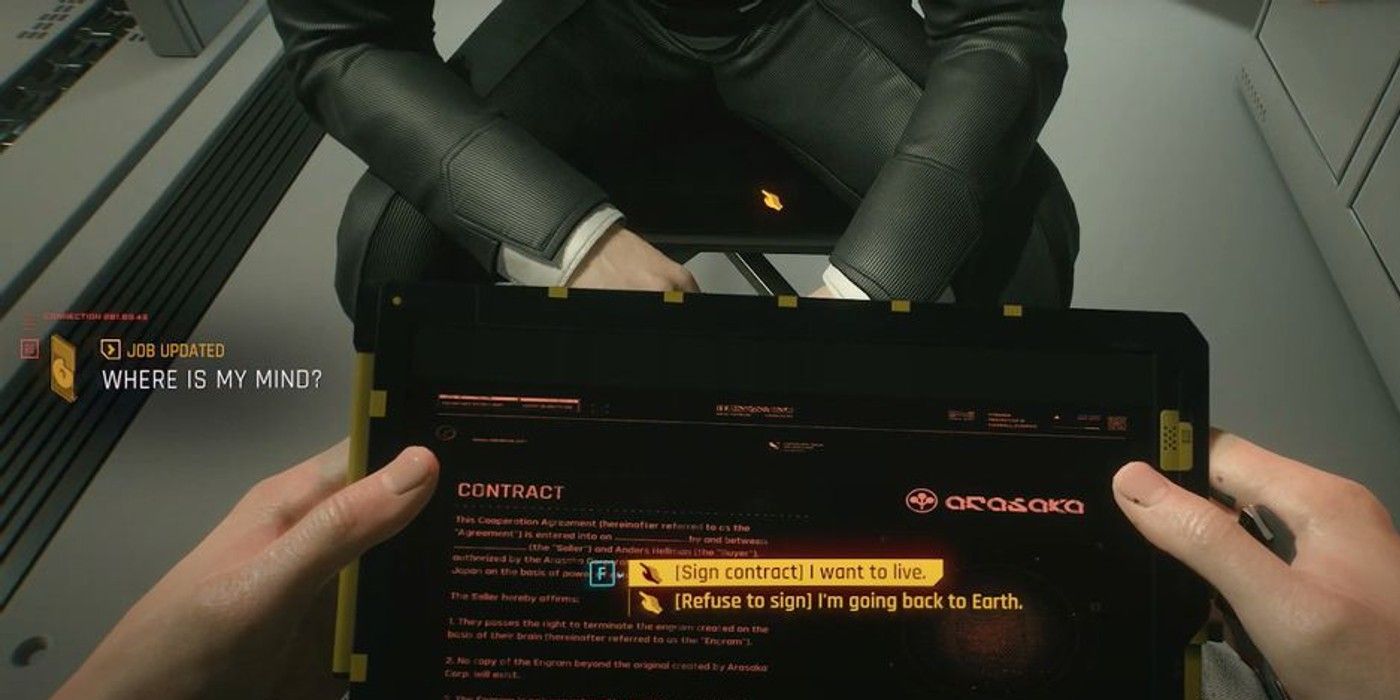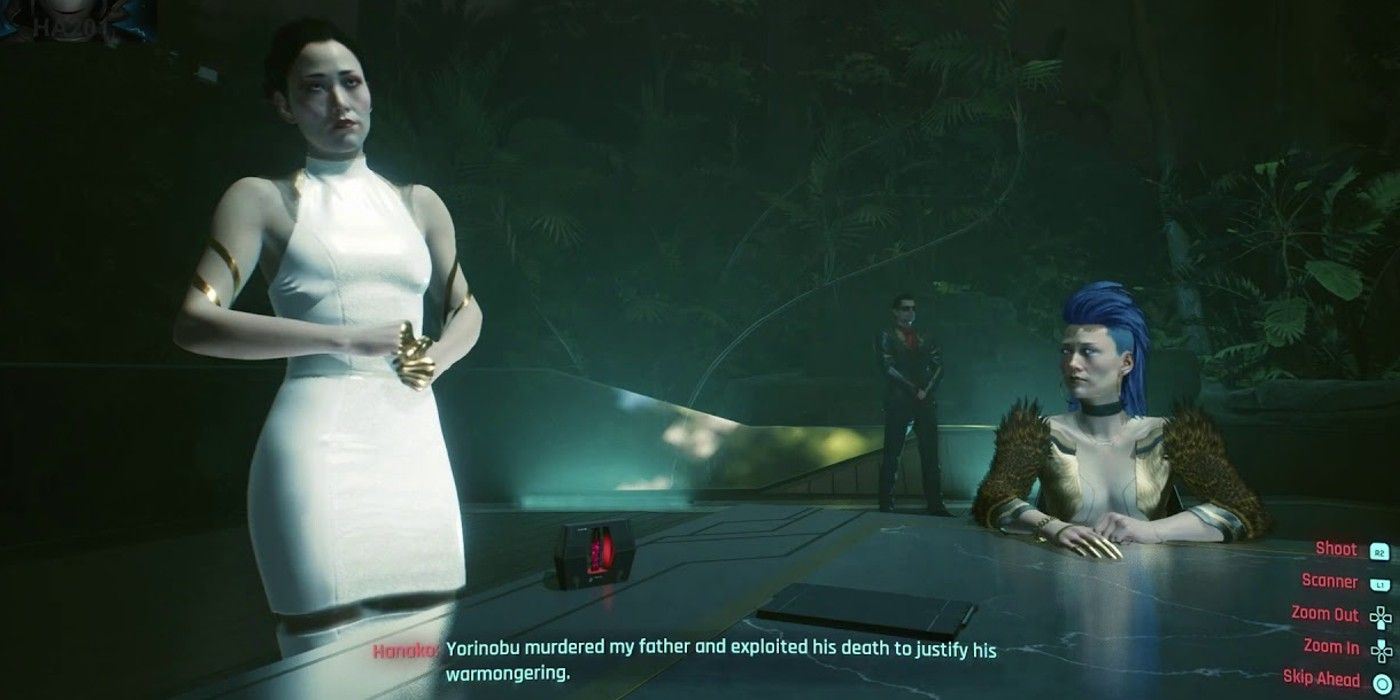Despite a rocky launch, Cyberpunk 2077 delivered an ambitious game featuring a competent main campaign story, a large number of side quests, and multiple endings, but one odd storytelling decision by developer CD Projekt Red was making the game’s default ending easily the least “punk” option available. The literary genre of cyberpunk shares some commonalities with the anti-authoritarian history of punk music, but Cyberpunk 2077 made its basic ending all about bowing to the whims of corrupt authority. There are more "rebellious" endings in Cyberpunk 2077, but these are all gated behind completing specific side quest chains. For players who followed the main quest line in Cyberpunk 2077, the game delivered the message that there is no fighting the status quo. The tabletop RPG from which Cyberpunk 2077 takes its setting contains four major axioms for player characters, the last of which are "Live on the Edge" and "Break the Rules." In videogame form, Cyberpunk 2077 made it harder to abide by these principles, as following the central storyline means adhering to corporate rulership.
[Warning: Spoilers for Cyberpunk 2077 below]
As a modern AAA game with a budget exceeding $300 million, Cyberpunk 2077 was clearly a product that garnered a lot of attention from stockholders and investors. Massive corporate products of this nature containing messages about the evils of unchecked capitalism always carry the weight of irony, but in the case of Cyberpunk 2077, it was easier for players to ultimately side with a megacorporation instead of lashing out against a broken system. Massive business conglomerates whose power exceeds nations are a key element of the cyberpunk genre, present since formative works like William Gibson’s Neuromancer. The story of Cyberpunk 2077 involves the player character V setting out to steal a piece of experimental technology from the Arasaka corporation, which leads to a resurgence of Johnny Silverhand’s decades old vendetta against the company. Unless players explore optional side stories, the only endings available are to work with the corporation or give up entirely.
While games with large worlds encourage exploration, and players are still finding hidden easter eggs in Cyberpunk 2077, the main quest line of any RPG usually contains its strongest storytelling. Side missions typically reveal more about the world, and a game’s supporting cast, but the main narrative has the greatest burden, as it gives the entire quest meaning and purpose. Cyberpunk 2077's story begins by introducing its protagonist, V, and someone who is out to earn fame and fortune as a mercenary alongside comrade Jackie Wells. After Wells dies on a mission to steal a piece of “relic technology” from the heir to the Arasaka corporation, V becomes the host for a biochip that contains the engram (a digital copy of a human mind) of the infamous rockerboy turned urban terrorist Silverhand. From then on, V’s quest is simply to find a means to survive, as the biochip will either kill V, or Silverhand’s engram will take over as the dominant personality.
Cyberpunk 2077's Default Endings Are The Worst (& Least Punk)
After chasing down a number of leads that reveal more about Silverhand’s past and V’s current predicament, players reach a point of no return in the story where they meet with Hanako Arasaka. This is the moment where players can choose from the various ending paths unlocked in Cyberpunk 2077. If the player single-mindedly followed the main story missions, it may not be evident that this is a branching point in the story, instead of a linear path. Side quests performed for Panam and her nomad allies, or Silverhand’s former partner Rogue, offer more “punk” options that involve an assault on Arasaka tower. Without delving into side quests, players are only given the option to trust a member of the Arasaka corporate family, or end V’s life.
Some players found all of Cyberpunk 2077’s endings unsatisfying because they seem unfinished, which was possibly by design, setting up a DLC follow up. It differs from typical RPG narratives which involve some threat to the region or the world, instead focusing on one person’s struggle for success, and then survival. The world is already arguably “doomed” in the future depicted in Cyberpunk 2077, and V initially finds Silverhand’s violent anti-corporate mindset off putting. The corruption and destructive influence of conglomerates like Arasaka is well-known but fighting back is considered futile by most in the setting, as these corporations are akin to forces of nature.
As the player learns more about Silverhand’s backstory, and Arasaka’s meddling with human consciousness, they are given more reasons to distrust the megacorporation and to harbor a personal grudge against Arasaka. An arc is suggested where V moves beyond the goal of survival and shifts to making a difference in the world. That arc never manifests, however, unless players engage in optional side content.
The default story path presents players with only Cyberpunk 2077’s worst endings, where V either elects to work alongside the same corporation that took the lives of Alt Cunningham, Silverhand, and Wells, or end their own life. It is possible that players could interpret this as an additional layer of storytelling from CD Projekt Red, where they illustrate that following the path of least resistance does not lead to change. More rebellious final acts are locked behind side missions, which entail stepping away from the main missions laid out by the game. Players are unlikely to give the story structure of Cyberpunk 2077 that much benefit of the doubt, however. A completionism-oriented playstyle is no more “punk” than a speed-running approach, and the story itself does not enforce the notion that V putting other missions over their own survival equates with rebelliousness.
Cyberpunk 2077's Ending Storytelling Issues Could Be Fixed
CD Projekt Red is still working to address bugs in Cyberpunk 2077, but the structure of its endings could also use an update. If the game had offered only the nihilistic “Easy Way Out” ending for players who did not pursue side quests, that would have been more coherent storytelling, and more thematically appropriate. To unlock endings where V calls upon a close ally like Panam or Rogue, or where they bond deeply with the Silverhand engram, the player must complete quests that develop those bonds of trust. It is bizarre that, despite seeing no evidence that the Arasaka corporation can be trusted, players are given just that as an ever-present option.
A series of side quests performed for Hanako Arasaka, where they come to regard her as more humane and trustworthy than the other members of her family, might help justify the “Where Is My Mind” ending of Cyberpunk 2077. As it stands, it is a strange storytelling decision to make V putting their faith in any member of the despotic Arasaka corporation the default for a narrative in a “punk” genre.



